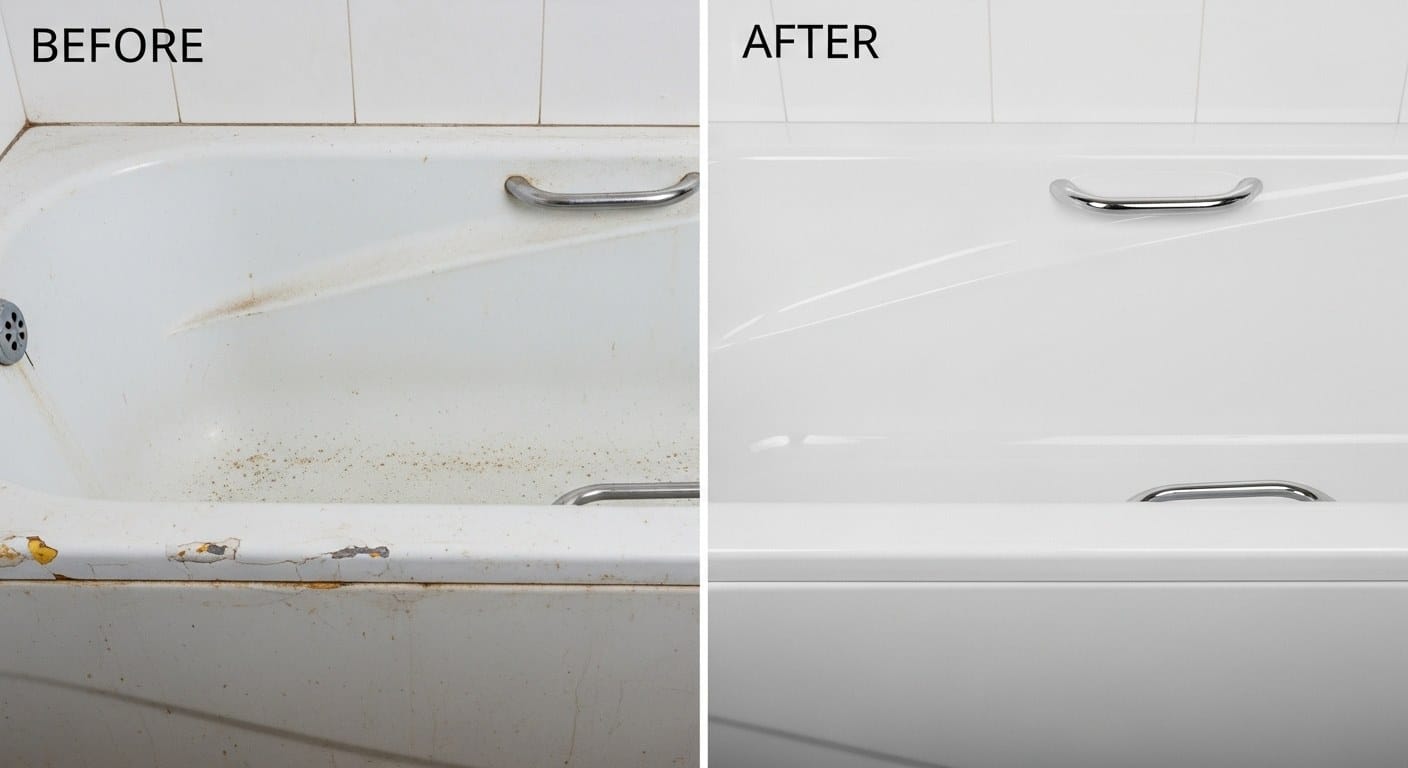Understanding the true bathtub refinishing cost is a crucial first step if your existing tub is showing its age but remains structurally sound. As an expert in bathroom transformations, I’ve seen countless outdated bathrooms revitalized, often with the worn-out tub being the primary focus.
A frequent question I encounter is, “Is refinishing a viable option, or should I just commit to a full replacement?” The answer typically hinges on cost, expected longevity, and your comfort level with the process. Let’s delve into the practical numbers and realities based on my hands-on experience in the field.
Understanding Professional Bathtub Refinishing Costs
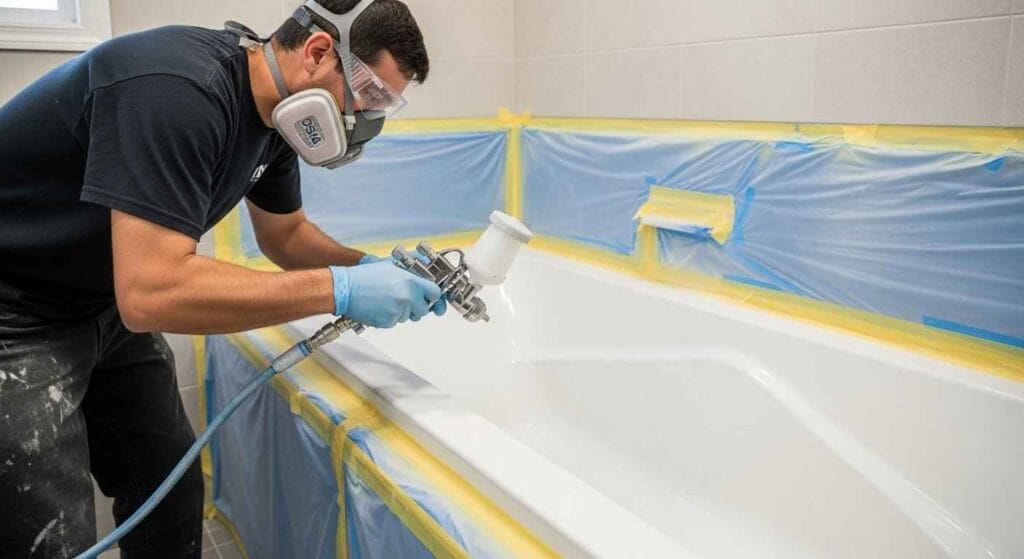
When you opt for professional tub refinishing, you can generally anticipate a price range of $300 to $650 for a standard bathtub. This service is far more extensive than a simple paint job; it involves a detailed, multi-step process that demands specialized skills and materials.
The exact cost can fluctuate based on your geographical location, with urban areas typically having higher labor rates, and the current condition of your tub. Tubs with significant chips, extensive rust, or previous subpar refinishing work will naturally require more intensive preparation, leading to a higher overall price for the bathtub restoration.
What Drives the Cost of Professional Tub Refinishing?
A professional refinishing job begins with thorough surface preparation. This involves meticulously cleaning the tub, often utilizing an acid etching solution to ensure optimal adhesion for the new coating. Any existing chips, cracks, or rust spots are carefully repaired and filled.
Next, the surrounding areas, including tiles and fixtures, are precisely masked off to protect them. The actual refinishing process entails applying multiple coats of a high-grade primer, followed by a durable topcoat, usually a two-part epoxy or an acrylic urethane.
These coatings are sprayed on using an HVLP system to achieve a smooth, factory-like finish. This is not a quick task; it typically requires a trained technician several hours, sometimes a full day, to execute correctly. The high-quality materials, such as premium PPG or Sherwin-Williams coatings designed for harsh bathroom environments, also contribute significantly to the overall bathtub refinishing cost.
The True Cost and Risks of DIY Bathtub Refinishing Kits
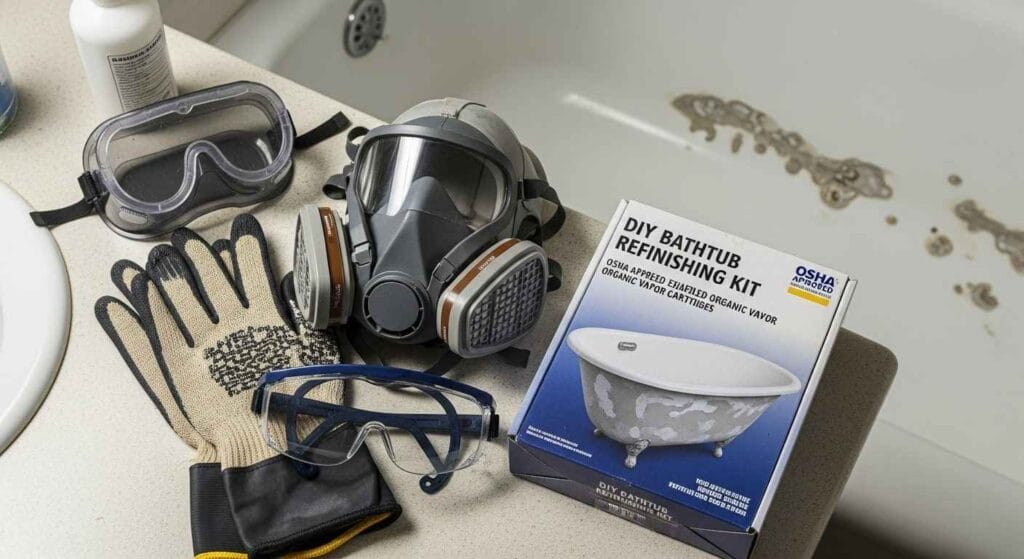
You might find DIY bathtub refinishing kits advertised for an enticing $50 to $200. These kits usually include a cleaner, an etching agent, and a one- or two-part epoxy coating meant for application with a roller or brush. On the surface, this appears to be a straightforward way to save money.
However, in my professional experience, homeowners often overlook the hidden expenses and the considerable difficulty in achieving a satisfactory result. I’ve frequently been called in to rectify DIY tub refinishing kit problems, and attempting to strip a poorly applied DIY finish before a proper professional job can sometimes add substantially to the total cost to refinish tub.
Essential Extras and Safety Gear Beyond the Kit Price
That basic $50 kit won’t suffice without a range of additional supplies. You will need specialized sandpaper, high-quality masking tape (cheap alternatives often bleed), plastic sheeting or drop cloths, and ample cleaning supplies. More importantly, safety gear is absolutely non-negotiable.
The fumes produced by these coatings are potent and hazardous. You will require an OSHA-approved respirator with organic vapor cartridges, effective ventilation fans, eye protection, and chemical-resistant gloves.
These critical items are not included in a standard kit and can easily add another $75 to $150 to your total, significantly diminishing your perceived “savings.” Furthermore, inadequate protection against these fumes can lead to serious health issues, a cost that simply cannot be quantified.
How Your Bathtub Material Impacts Refinishing Cost
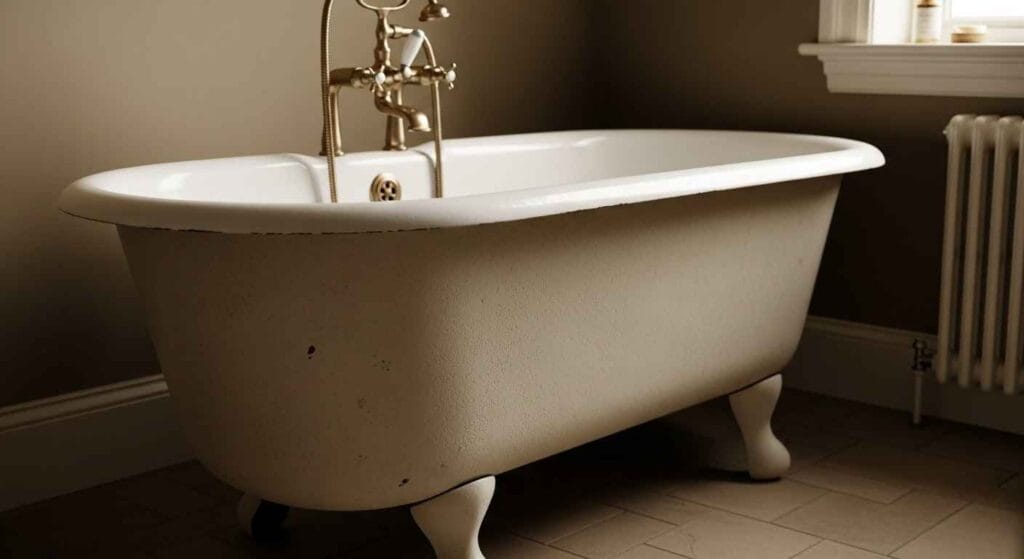
The specific material of your bathtub significantly influences the overall bathtub refinishing cost. Different materials demand varying levels of surface preparation and sometimes require specialized primers or application techniques. Understanding this distinction can help you better anticipate your expenses for bathtub restoration.
For a fiberglass tub refinishing cost, you might see prices ranging from $300 to $1,000. Fiberglass can present unique challenges due to its inherent flexibility.
Any underlying structural weaknesses or stress cracks will need to be addressed before refinishing, which adds to both labor and material costs. A common error I observe is failing to adequately account for the tub’s flex, which can lead to premature cracking of the new finish.
Porcelain tubs, a timeless bathroom fixture, typically fall within $350 to $600 for refinishing. Porcelain surfaces are generally very receptive to refinishing materials once properly etched and cleaned. They tend to bond exceptionally well with new finishes because the original surface is remarkably hard and stable. The majority of the work here involves meticulous cleaning and etching to ensure perfect adhesion, followed by the application of a high-quality, durable coating.
Cast iron tub refinishing cost is usually in the $350 to $650 range. These tubs are renowned for their incredible durability and substantial weight, making them prime candidates for refinishing. Similar to porcelain, they provide a very stable base. The primary concern with cast iron is often rust, particularly around the drain or in chipped areas.
Properly treating and neutralizing rust, then filling any pits, is crucial for a long-lasting finish, and this detailed repair work can push the cost towards the higher end of the spectrum. However, for a tub that can last a century, this is often a highly worthwhile investment.
Refinish Bathtub vs. Replace: Significant Savings Explained
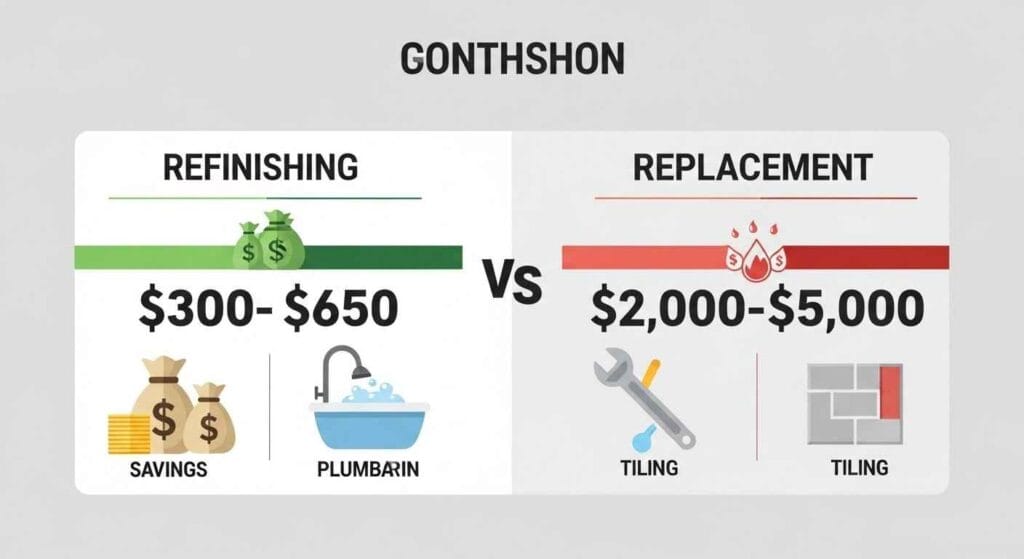
This is where refinishing truly stands out for many homeowners seeking bathtub restoration. When you compare to refinish bathtub vs replace, refinishing can generate substantial savings, often 75% or more when contrasted with the $2,000 to $5,000 expense of replacing an entire bathtub.
This represents a significant financial difference, especially if you are working with a tight bathroom renovation budget. I’ve encountered numerous projects where clients were contemplating removing a perfectly serviceable cast iron tub, and I consistently advise them to consider refinishing first, provided the tub is structurally sound.
Uncovering the Hidden Expenses of Bathtub Replacement
The price of a new tub itself, which can range from a few hundred to several thousand dollars, is merely the initial expense. Tub replacement triggers a cascade of additional costs. First, there’s the demolition of the old tub, a messy and time-consuming process, particularly for heavy cast iron units.
Then, you will likely need plumbing modifications to accommodate the new tub, necessitating the involvement of a licensed plumber. Most significantly, you will almost certainly require tile repair or replacement around the tub, as existing tiles often sustain damage during removal.
This can extend to regrouting or even re-tiling an entire wall if matching tiles are unavailable. Do not overlook waste disposal fees for the old tub and other construction debris. All these elements quickly accumulate, transforming what appears to be a simple tub swap into a full-scale mini renovation. Bathtub refinishing skillfully bypasses nearly all these additional trades and their associated expenses.
Expected Lifespan and Warranty of a Professionally Refinished Bathtub
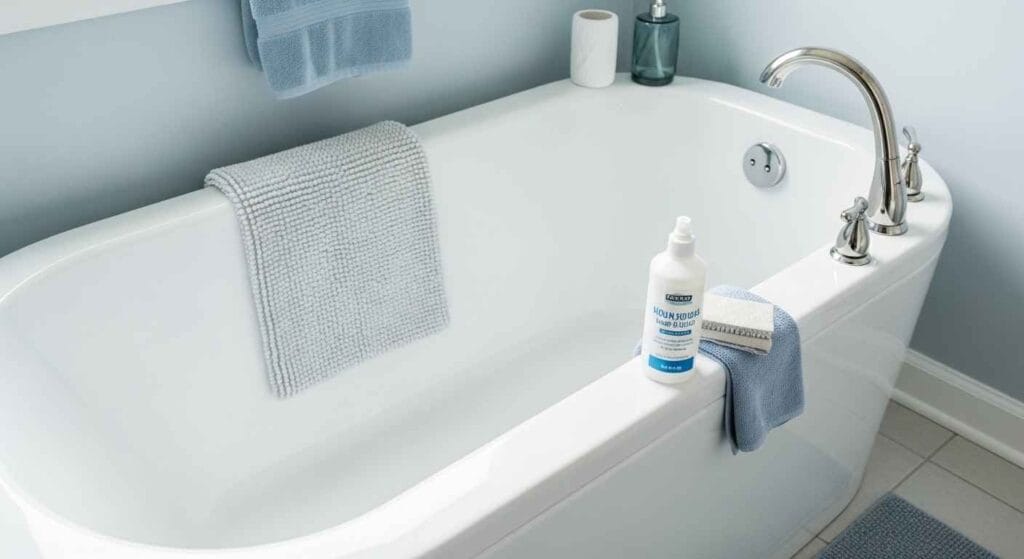
When executed expertly by a professional, you can expect a refinished bathtub to last a solid 10 to 15 years. This offers a substantial return on your investment, effectively providing you with a “new” tub for a fraction of the cost of replacement. Most reputable professionals will also provide a warranty on their work, typically ranging from 3 to 10 years.
This warranty generally covers issues such as peeling, blistering, or fading, provided the damage is not a result of misuse or abrasive cleaning. Always inquire about the specific terms and conditions of the warranty before engaging a professional.
Expert Tips for Maximizing Your Refinished Tub’s Lifespan
The longevity of your professionally refinished tub depends not only on the quality of the initial job but also on your ongoing maintenance. I consistently advise my clients that gentle care is paramount.
Avoid harsh, abrasive cleaners like Comet or scouring pads, as these can dull or scratch the new finish. Instead, opt for non-abrasive, mild liquid cleaners (such as dish soap or specially formulated tub cleaners) applied with a soft cloth or sponge. Good ventilation is equally crucial.
After baths or showers, ensure the bathroom is well-ventilated to prevent moisture buildup, which can eventually lead to issues. Even minor details, like using a bathmat to prevent slips and protect the finish from impacts, can significantly contribute to getting the full 10 to 15 years out of your beautiful, refreshed tub.
Choosing to refinish your bathtub involves understanding the costs, the process, and your long-term expectations. From my expert perspective, professional bathtub refinishing is often the most intelligent choice for homeowners looking to revitalize their bathroom without incurring significant expense or undertaking a major demolition project.
It offers a fresh start for your tub and considerably extends its useful life. Considering your tub’s material and current condition, are you ready to explore this cost-effective transformation? Contact a local professional today for a detailed estimate and bring your tub back to life.
How long can I expect a professional refinish to last?
With proper application by a skilled professional and diligent maintenance, a quality bathtub refinish should comfortably last 10 to 15 years. Key factors include the technician’s thorough preparation, the quality of materials used, and your commitment to using non-abrasive cleaners and soft cloths.
Is refinishing my bathtub a smart investment?
In most scenarios, absolutely. If your tub is structurally sound but simply appears worn out or chipped, bathtub refinishing is an incredibly cost-effective solution. It can save you 75% or more compared to a full replacement, avoiding the extensive demolition, plumbing, and tiling costs associated with a complete tear-out.
What’s the difference between reglazing and refinishing a tub?
In the industry, the terms “reglazing” and “refinishing” are often used interchangeably. Both refer to the process of restoring the surface of an existing tub. There is no functional difference in how professionals approach the job, which involves thorough cleaning, repair, and the application of a new, durable coating.




